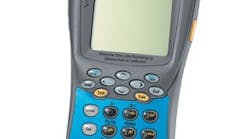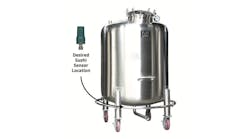By Dave Hrivnak
We see many ways wireless has improved our lives and made them easier. We surround ourselves with TV remotes, cordless phones for home, and cell phones when we are traveling about. Although it seems that most chemical plants have turned a blind eye to this technology, Eastman Chemical Co. has not. The company has been applying wireless technology where it makes sense to cut costs and to make our employees more productive.
Wireless LANs
Wireless technology allows the author, Dave Hrivnak, to complete his work on a laptop under a variety of circumstances.
I use a wireless Internet connection at home. With prices typically less than $80 for a combination four-port hub, router and wireless access point, it is rarely worth the trouble to run Ethernet wires. While the home access points are inexpensive, the range is only about 50 ft., and can be less if you are trying to transmit through a block wall or have metal lathing in your home. For me, wireless has made working at home tolerable. Now I can sit with my family without stringing wires across the floor or out to the patio. With my setup, I can quickly go from home to work to my local Internet cafe and enjoy a high-speed connection without a reboot. My laptop automatically detects the wireless access point, and all I need to do when I'm away from work is start Eastman's Virtual Private Network (VPN) software for a secure connection to the office.
While traveling, wireless is a big help in staying connected. Our local airport has free wireless access, so in the event your plane is delayed, you can boot up your laptop and have a high-speed connection from anywhere in the terminal. Many airports have free or low-cost wireless access available. There are more than 40,000 wireless hotspots nationwide that give 10 times the speed of a dial-up connection.
Eastman has installed hundreds of wireless access points in offices around the world. When I visit another plant site, all I need is an empty cubicle or office. With my wireless laptop and cell phone, the new office is ready for business in less than a minute. By installing wireless in most offices, we have seen additional benefits, such as improved collaboration. It is so easy to pick up your laptop and move to a co-worker's office to work on a problem. With so many files and data on the network, the instant access allows us to quickly show and share our findings. Wireless access is also very handy on days in which you spend much of your time going from one meeting to another. Meetings frequently end a little early and I can then open my laptop and do a few minutes of additional work.
Symbol Technologies' intrinsically safe, handheld terminal.
Eastman has applied the benefits of wireless LAN technology to applications in our warehouses. Eastman partnered with Symbol Technologies to bring an i-Safe (intrinsically safe) version of their popular PDT8146 to market. This handheld terminal runs Microsoft's Pocket PC operating system and has a built-in bar code scanner and wireless LAN. We have written an interface directly into SAP so operators on the warehouse floor can perform inventory movements, receipts and shipments in real time. This has improved accuracy, timeliness and has reduced labor, as we no longer have to track changes on log sheets and retype them into SAP.
A final area in which we have seen savings with wireless LANs is our rotational analysis group. If a large piece of equipment is out of balance, it can really drive up maintenance costs. Eastman has a test machine that mechanics take to the field. It can connect multiple accelerometers on a piece of problem equipment to measure and pinpoint vibrations. This test equipment needs an Ethernet connection, and there is rarely one nearby in the plant. It would take weeks and a lot of labor to run Ethernet for this test instrument, greatly adding to the cost. We plug in a temporary wireless access point and a wireless bridge and can put the instrument in most any location in a matter of hours, rather than weeks. The wireless setup of off-the-shelf parts paid for itself in the first installation.
Security
Wireless WAN
Handspring's Treo 600 PDA/phone.
I take advantage of this in two ways. The new Treo 600 PDA/phone gives me one small, convenient device that that is not only a great phone, but will wirelessly synchronize e-mail, calendar, contacts, notes and tasks. This summer, when I took the Scouts on a traveling summer camp, I got up a few minutes before it was time to wake the boys. During that time, I was able to address any critical needs at work. When I arrived at the office after my week off, I had already answered 85% of my e-mails and deleted them, making the return far less hectic. Eastman uses Pylon software from iAnywhere to synchronize with MS Exchange.
For more serious work with laptops, we use Sprint's wireless data cards to give dial-up performance from almost anywhere a cell phone works. This is great for our sales force or managers on the road because they can look up customer information just prior to a meeting. They can synchronize data while they travel, saving considerable amounts of time. Within two years, the wireless networks will probably approach DSL speeds, providing both great coverage and speed from nearly anywhere in the United States.
Wireless Sensors
These wireless transmitters can monitor gauge pressure, absolute pressure, temperature and ultrasonic noise (for detecting steam and gas leaks). These devices also include an analog input interface for adding wireless capabilities to 4-20 mA devices. These devices completely cut the cord. They operate on a battery designed to last at least three years.
The instruments wirelessly transmit measurements up to 2,000 ft. to a base radio connected to a control system or data acquisition device. Each base radio accepts the signals of up to 50 transmitters. The base radio provides Modbus or 4-20 mA analog signal output for flexible communications.
Eastman has begun field trials of wireless sensors, and so far they have worked well. They reduce the installation cost and time compared to traditional wired sensors.
Wireless technology is all around us, and offers many benefits. The prices for most wireless technologies have dropped so much that it pays to keep an eye on the technology, if not for work, then at least for home use. But if you go wireless, spend a few extra minutes turning on the basic security features to ensure your system is safe and secure.
Dave Hrivnak is mobile projects manager for Eastman Chemical Co., Kingsport, Tenn. Visit him at www.hrivnak.com.


